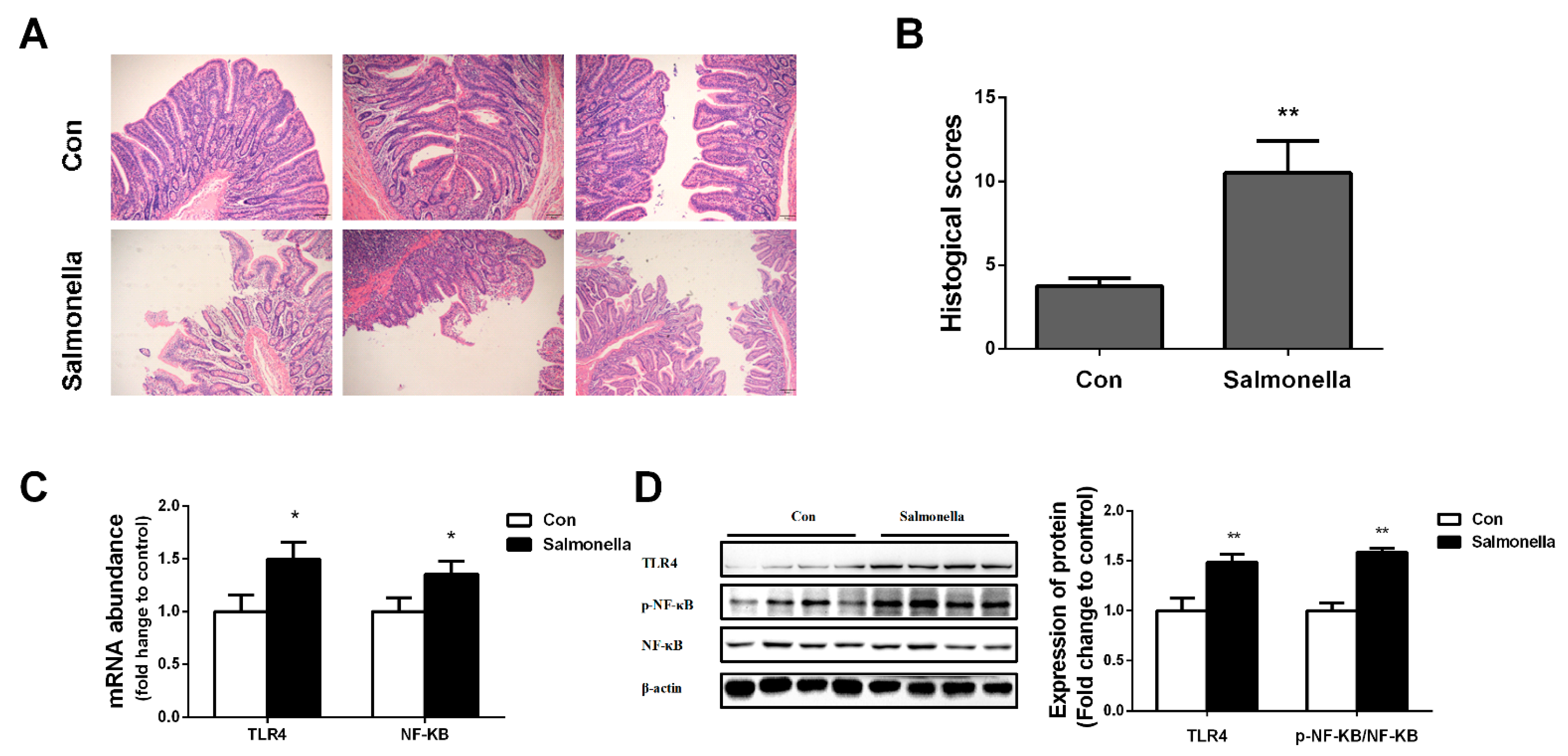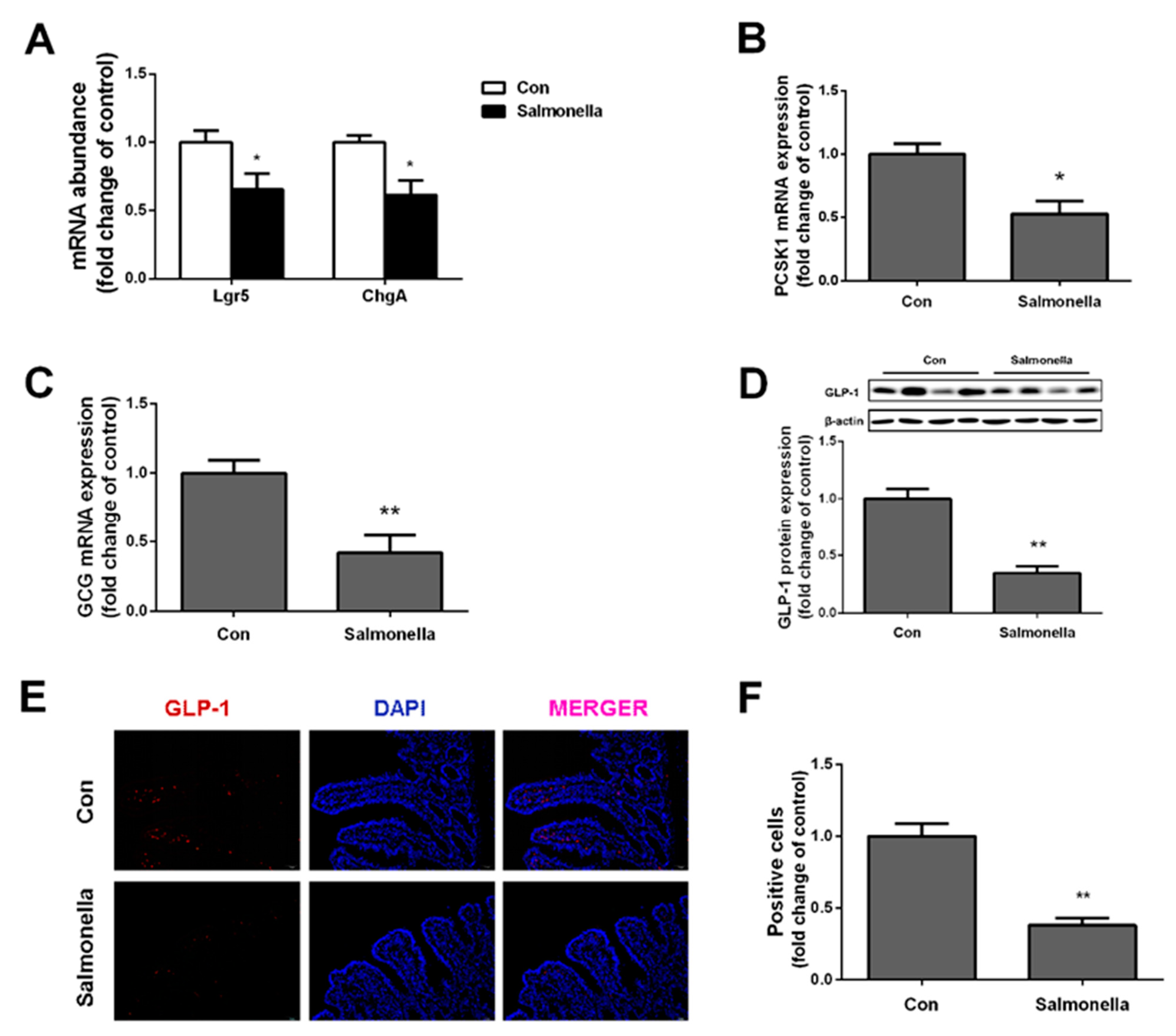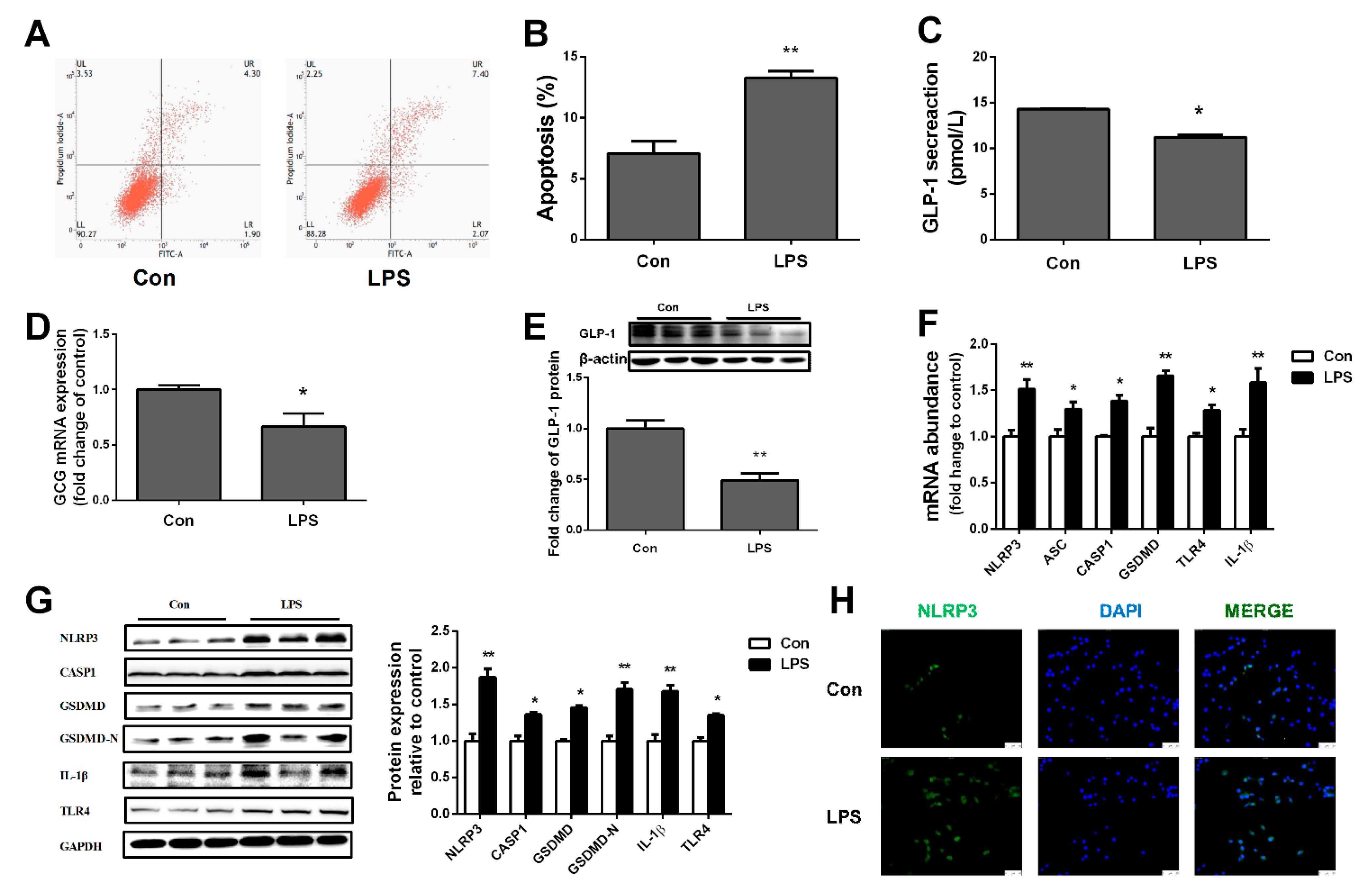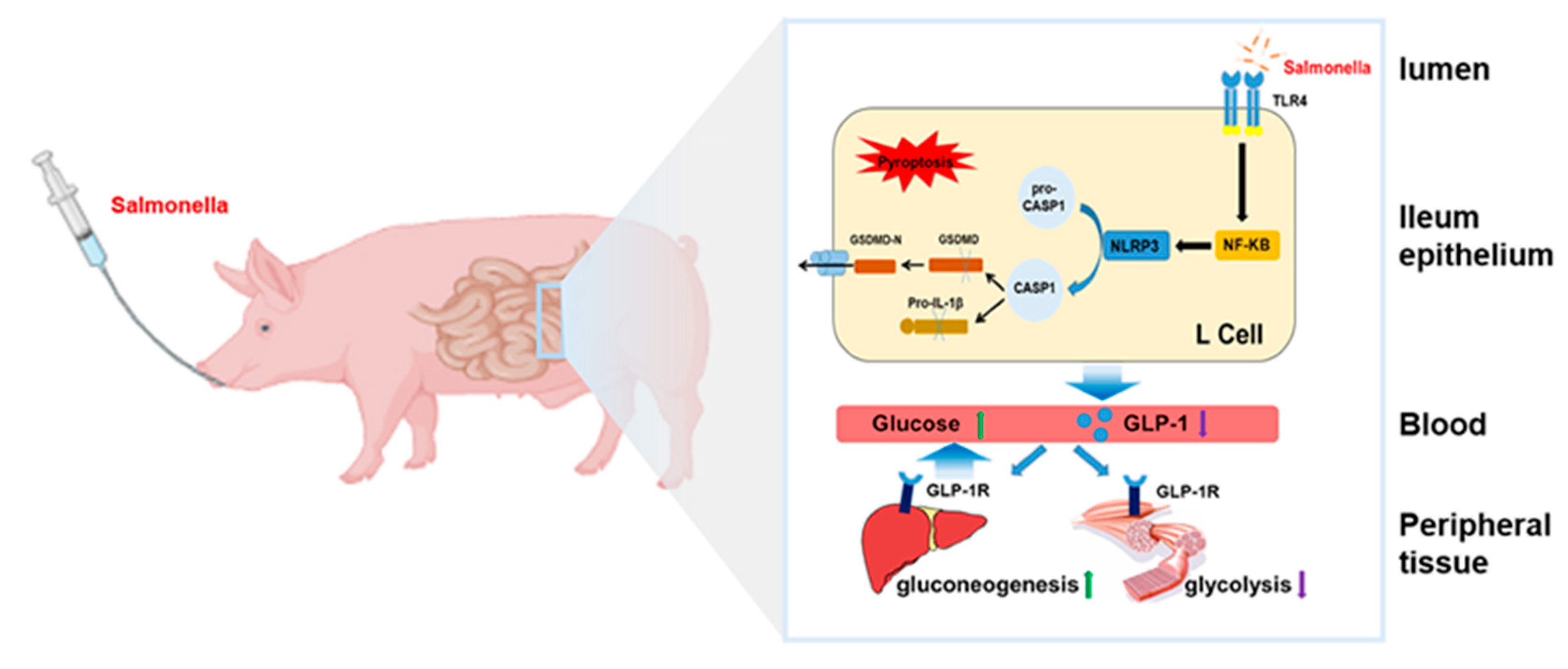Salmonella Infection Causes Hyperglycemia for Decreased GLP-1 Content by Enteroendocrine L Cells Pyroptosis in Pigs
Abstract
:1. Introduction
2. Results
2.1. Effects of Salmonella Infection on Plasma Parameters of Piglets
2.2. Effects of Salmonella Infection on Ileum Inflammation
2.3. Effects of Salmonella Infection on GLP-1 Secretion in Ileum
2.4. Effects of Salmonella Infection on Pyroptosis Signal Pathway in Ileum
2.5. Effects of Salmonella Infection on GLP-1R and Glucose Metabolism in Liver and Muscle
2.6. LPS inhibited the Production of GLP-1 by Inducing Pyroptosis in STC-1 Cells
3. Discussion
4. Materials and Methods
4.1. Animals
4.2. Cell Culture
4.3. RNA Isolation and Quantitative Real-Time PCR
4.4. Western Blot Analysis
4.5. ELISA
4.6. Immunofluorescence Analysis
4.7. Histopathology of the Ileum
4.8. Apoptosis Analysis Using Flow Cytometry
4.9. Statistical Analysis
5. Conclusions
Author Contributions
Funding
Institutional Review Board Statement
Informed Consent Statement
Data Availability Statement
Conflicts of Interest
References
- Zhao, H.; Ma, T.; Fan, B.; Yang, L.; Han, C.; Luo, J.; Kong, L. Protective effect of trans-delta-viniferin against high glucose-induced oxidative stress in human umbilical vein endothelial cells through the SIRT1 pathway. Free Radic. Res. 2016, 50, 68–83. [Google Scholar] [CrossRef]
- Bhatt, M.P.; Lim, Y.C.; Hwang, J.; Na, S.; Kim, Y.M.; Ha, K.S. C-peptide prevents hyperglycemia-induced endothelial apoptosis through inhibition of reactive oxygen species-mediated transglutaminase 2 activation. Diabetes 2013, 62, 243–253. [Google Scholar] [CrossRef] [Green Version]
- Van Niekerk, G.; Engelbrecht, A.M. Inflammation-induced metabolic derangements or adaptation: An immunometabolic perspective. Cytokine Growth Factor Rev. 2018, 43, 47–53. [Google Scholar] [CrossRef]
- Smyl, C. Ketogenic Diet and Cancer-a Perspective. Recent Results Cancer Res. 2016, 207, 233–240. [Google Scholar]
- Marcovecchio, M.L.; Chiarelli, F. The effects of acute and chronic stress on diabetes control. Sci. Signal 2012, 5, 10. [Google Scholar]
- Danicke, S.; Brosig, B.; Kersten, S.; Kluess, J.; Kahlert, S.; Panther, P.; Diesing, A.K.; Rothkotter, H.J. The Fusarium toxin deoxynivalenol (DON) modulates the LPS induced acute phase reaction in pigs. Toxicol. Lett. 2013, 220, 172–180. [Google Scholar] [CrossRef]
- Hotamisligil, G.S. Mechanisms of TNF-alpha-induced insulin resistance. Exp. Clin. Endocrinol. Diabetes 1999, 107, 119–125. [Google Scholar] [CrossRef]
- Gugliandolo, E.; Licata, P.; Peritore, A.F.; Siracusa, R.; D’Amico, R.; Cordaro, M.; Fusco, R.; Impellizzeri, D.; Di Paola, R.; Cuzzocrea, S.; et al. Effect of Cannabidiol (CBD) on Canine Inflammatory Response: An Ex Vivo Study on LPS Stimulated Whole Blood. Vet. Sci. 2021, 8, 185. [Google Scholar] [CrossRef]
- Lee, Y.S.; Jun, H.S. Anti-diabetic actions of glucagon-like peptide-1 on pancreatic beta-cells. Metabolism 2014, 63, 9–19. [Google Scholar] [CrossRef]
- Huang, S.; Ma, S.; Ning, M.; Yang, W.; Ye, Y.; Zhang, L.; Shen, J.; Leng, Y. TGR5 agonist ameliorates insulin resistance in the skeletal muscles and improves glucose homeostasis in diabetic mice. Metabolism 2019, 99, 45–56. [Google Scholar] [CrossRef]
- Antunes, L.C.; Finlay, B.B. A comparative analysis of the effect of antibiotic treatment and enteric infection on intestinal homeostasis. Gut Microbes 2011, 2, 105–108. [Google Scholar] [CrossRef]
- Shi, J.; Gao, W.; Shao, F. Pyroptosis: Gasdermin-Mediated Programmed Necrotic Cell Death. Trends Biochem. Sci. 2017, 42, 245–254. [Google Scholar] [CrossRef]
- Martinon, F.; Mayor, A.; Tschopp, J. The inflammasomes: Guardians of the body. Annu. Rev. Immunol. 2009, 27, 229–265. [Google Scholar] [CrossRef] [Green Version]
- Swanson, K.V.; Deng, M.; Ting, J.P. The NLRP3 inflammasome: Molecular activation and regulation to therapeutics. Nat. Rev. Immunol. 2019, 19, 477–489. [Google Scholar] [CrossRef]
- Wang, Y.; Zhang, H.; Chen, Q.; Jiao, F.; Shi, C.; Pei, M.; Lv, J.; Zhang, H.; Wang, L.; Gong, Z. TNF-alpha/HMGB1 inflammation signalling pathway regulates pyroptosis during liver failure and acute kidney injury. Cell Prolif. 2020, 53, e12829. [Google Scholar] [CrossRef]
- Huang, S.M.; Wu, Z.H.; Li, T.T.; Liu, C.; Han, D.D.; Tao, S.Y.; Pi, Y.; Li, N.; Wang, J.J. Perturbation of the lipid metabolism and intestinal inflammation in growing pigs with low birth weight is associated with the alterations of gut microbiota. Sci. Total Environ. 2020, 719, 137382. [Google Scholar] [CrossRef]
- Fattinger, S.A.; Bock, D.; Di Martino, M.L.; Deuring, S.; Samperio, V.P.; Ek, V.; Furter, M.; Kreibich, S.; Bosia, F.; Muller-Hauser, A.A.; et al. Salmonella Typhimurium discreet-invasion of the murine gut absorptive epithelium. PLoS Pathog. 2020, 16, e1008503. [Google Scholar] [CrossRef]
- Dokladny, K.; Zuhl, M.N.; Moseley, P.L. Intestinal epithelial barrier function and tight junction proteins with heat and exercise. J. Appl. Physiol. 2016, 120, 692–701. [Google Scholar] [CrossRef]
- Fluck, K.; Fandrey, J. Oxygen sensing in intestinal mucosal inflammation. Pflugers Arch. 2016, 468, 77–84. [Google Scholar] [CrossRef]
- Schultz, B.M.; Salazar, G.A.; Paduro, C.A.; Pardo-Roa, C.; Pizarro, D.P.; Salazar-Echegarai, F.J.; Torres, J.; Riedel, C.A.; Kalergis, A.M.; Alvarez-Lobos, M.M.; et al. Persistent Salmonella enterica serovar Typhimurium Infection Increases the Susceptibility of Mice to Develop Intestinal Inflammation. Front. Immunol. 2018, 9, 1166. [Google Scholar] [CrossRef] [Green Version]
- Suwandi, A.; Galeev, A.; Riedel, R.; Sharma, S.; Seeger, K.; Sterzenbach, T.; Garcia, P.L.; Boyle, E.C.; Gal-Mor, O.; Hensel, M.; et al. Std fimbriae-fucose interaction increases Salmonella-induced intestinal inflammation and prolongs colonization. PLoS Pathog. 2019, 15, e1007915. [Google Scholar] [CrossRef] [PubMed] [Green Version]
- Arguello, H.; Estelle, J.; Zaldivar-Lopez, S.; Jimenez-Marin, A.; Carvajal, A.; Lopez-Bascon, M.A.; Crispie, F.; O’Sullivan, O.; Cotter, P.D.; Priego-Capote, F.; et al. Early Salmonella Typhimurium infection in pigs disrupts Microbiome composition and functionality principally at the ileum mucosa. Sci. Rep. 2018, 8, 7788. [Google Scholar] [CrossRef] [PubMed] [Green Version]
- Drucker, D.J. Mechanisms of Action and Therapeutic Application of Glucagon-like Peptide-1. Cell Metab. 2018, 27, 740–756. [Google Scholar] [CrossRef] [Green Version]
- Muller, T.D.; Finan, B.; Bloom, S.R.; D’Alessio, D.; Drucker, D.J.; Flatt, P.R.; Fritsche, A.; Gribble, F.; Grill, H.J.; Habener, J.F.; et al. Glucagon-like peptide 1 (GLP-1). Mol. Metab. 2019, 30, 72–130. [Google Scholar] [CrossRef]
- Aulinger, B.A.; Vahl, T.P.; Wilson-Perez, H.E.; Prigeon, R.L.; D’Alessio, D.A. beta-Cell Sensitivity to GLP-1 in Healthy Humans Is Variable and Proportional to Insulin Sensitivity. J. Clin. Endocrinol. Metab. 2015, 100, 2489–2496. [Google Scholar] [CrossRef]
- Rehman, K.; Ali, M.B.; Akash, M. Genistein enhances the secretion of glucagon-like peptide-1 (GLP-1) via downregulation of inflammatory responses. Biomed. Pharmacother. 2019, 112, 108670. [Google Scholar] [CrossRef]
- Karki, R.; Lee, E.; Place, D.; Samir, P.; Mavuluri, J.; Sharma, B.R.; Balakrishnan, A.; Malireddi, R.; Geiger, R.; Zhu, Q.; et al. IRF8 Regulates Transcription of Naips for NLRC4 Inflammasome Activation. Cell 2018, 173, 920–933. [Google Scholar] [CrossRef] [Green Version]
- Bierschenk, D.; Monteleone, M.; Moghaddas, F.; Baker, P.J.; Masters, S.L.; Boucher, D.; Schroder, K. The Salmonella pathogenicity island-2 subverts human NLRP3 and NLRC4 inflammasome responses. J. Leukoc. Biol. 2019, 105, 401–410. [Google Scholar] [CrossRef]
- Lamkanfi, M.; Dixit, V.M. Mechanisms and functions of inflammasomes. Cell 2014, 157, 1013–1022. [Google Scholar] [CrossRef] [Green Version]
- Fink, S.L.; Cookson, B.T. Pyroptosis and host cell death responses during Salmonella infection. Cell. Microbiol. 2007, 9, 2562–2570. [Google Scholar] [CrossRef]
- Moraes-Vieira, P.M.; Yore, M.M.; Sontheimer-Phelps, A.; Castoldi, A.; Norseen, J.; Aryal, P.; Simonyte, S.K.; Kahn, B.B. Retinol binding protein 4 primes the NLRP3 inflammasome by signaling through Toll-like receptors 2 and 4. Proc. Natl. Acad. Sci. USA 2020, 117, 31309–31318. [Google Scholar] [CrossRef]
- He, W.T.; Wan, H.; Hu, L.; Chen, P.; Wang, X.; Huang, Z.; Yang, Z.H.; Zhong, C.Q.; Han, J. Gasdermin D is an executor of pyroptosis and required for interleukin-1beta secretion. Cell Res. 2015, 25, 1285–1298. [Google Scholar] [CrossRef] [PubMed]
- Lei, L.; Wang, J.; Zhang, Z.; Zhang, H.; Chen, H.; Cai, D. Lipopolysaccharide-induced apoptosis in a murine intestinal endocrine cell line by modulation of Bcl-2, Bax and caspase-3. Mol. Med. Rep. 2013, 8, 1649–1654. [Google Scholar] [CrossRef]
- Wang, J.; Wang, X.; Li, Z.Z.; Guo, F.; Ding, C.Z.; Zhao, Y.Y.; Liu, Y.L.; Ma, X.J.; Li, C.; Wu, L.N.; et al. The apoptosis and GLP-1 hyposecretion induced by LPS via RIP/ROS/mTOR pathway in GLUTag cells. Biochimie 2019, 162, 229–238. [Google Scholar] [CrossRef]






| Parameters | Con | Salmonella | p-Value |
|---|---|---|---|
| TNFα (pg/mL) | 10.17 ± 1.76 | 35.26 ± 2.49 | 0.007 |
| IL-10 (pg/mL) | 286.43 ± 25.72 | 196.91 ± 7.95 | 0.032 |
| FBG (mmol/L) | 2.46 ± 0.36 | 4.59 ± 0.29 | 0.002 |
| FINS (mIU/L) | 13.82 ± 0.95 | 11.13 ± 0.88 | 0.039 |
| GLP-1 (pmol/L) | 12.74 ± 0.58 | 9.54 ± 0.49 | 0.009 |
| HOMA-IR | 1.47 ± 0.11 | 2.36 ± 0.27 | 0.023 |
| Target Genes | GenBank Accession Number | Primer Sequences |
|---|---|---|
| β-actin | NM_007393 | F:5′-CCACCATGTACCCAGGCATT-3′ R:5′-CAGCTCAGTAACAGTCCGCC-3′ |
| GCG | NM_008100.4 | F:5′-TCTACACCTGTTCGCAGCTC-3′ R:5′-TCCTCATGCGCTTCTGTCTG-3′ |
| NLRP3 | NM_001359638.1 | F:5′-AGCCAGAGTGGAATGACACG-3′ R:5′-CGTGTAGCGACTGTTGAGGT-3′ |
| ASC | NM_023258.4 | F:5′-AACTGCGAGAAGGCTATGGG-3′ R:5′-CTGGCTGTACTCTGAGCAGG-3′ |
| Caspase1 | NM_009807.2 | F:5′-GGACTGACTGGGACCCTCAA-3′ R:5′-TACCCCAGATCCTCCAGCAG-3′ |
| GSDMD | XM_006521343 | F:5′-GGGGATGACCTGTTTGTGGT-3′ R:5′-ATAAGCAGTTGGGCCACTCG-3′ |
| TLR4 | XM_036163964.1 | F:5′-CCACAAGAGCCGGAAGGTTA-3′ R:5′-CAGAAGATGTGCCTCCCCAG-3′ |
| IL-1β | NM_008361.4 | F:5′-GTGCAAGTGTCTGAAGCAGC-3′ R:5′-CAAAGGTTTGGAAGCAGCCC-3′ |
| Target Genes | GenBank Accession Number | Primer Sequences |
|---|---|---|
| GAPDH | NM_001206359.1 | F:5′-GTATGATTCCACCCACGGCA-3′ R:5′-CACCCCATTTGATGTTGGCG-3′ |
| GCG | NM_214324 | F:5′-GTTAATCCAGACAGCCATGCG-3′ R:5′-TGACCTGAGGACTGCTTTCAC-3′ |
| PCSK1 | NM_214038 | F:5′-GTTGCGAAGGTAGCGG-3′ R:5′-CAATGGCAGAGGATGGTA-3′ |
| G6PC | NM_001113445.1 | F:5′-GTGATCGCGGACCTCAGAAA-3′ R: 5′-AGCCAGTCTCCAATCACAGC-3′ |
| GSK3β | NM_001128443 | F:5′-CTGCCCAAGGCAGAGAAACT-3′ R: 5′-ATTCAGATTGCCCAAGCCGT-3′ |
| PCK1 | NM_001123158.1 | F: 5′-CCTCCTCAGCTCTCAAACGG-3′ R: 5′-AGCCAACCAGCAGTTGTCAT-3′ |
| HK2 | NM_001122987 | F:5′-GACTCAAGACGAGGGGCATC-3′ R: 5′-CGTCACTTTGAGGGTGTCCA-3′ |
| GLUT4 | NM_001128433 | F: 5′-TGGACGGTTCCTCATTGGTG-3′ R: 5′-GTGATGCCCAGGAGTAGTGG-3′ |
| NF-ΚB | NM_001279309 | F:5′-ACCATTGCTAAACTCCGCCA-3′ R:5′-GAATGGTGGAGTGCTTCCCT-3′ |
| NLRP3 | NM_001256770 | F:5′-TCGGGGCCAGACAGAAAAAG-3′ R:5′- CCCATTCTGGCTCATCCCTC-3′ |
| ASC | XM_003124468 | F:5′-AGCAGACAACAAACCAGCAC-3′ R:5′-TCCACGTCTGTGACCCTTGA-3′ |
| Caspase1 | NM_001043585.1 | F:5′-AACGGCAATGAAGACGAAGG -3′ R:5′-ATTTTCGCATAACGTCGCCC -3′ |
| GSDMD | XM_021090506.1 | F:5′-GGAACGATGTGTTCGTGGTG -3′ R:5′-CCCGAAATGCAATGACGCTG -3′ |
| IL-1β | NM_214055.1 | F:5′-AGGCTGGAGAAAAAGCAGCA-3′ R:5′-CCCGGTACAGATGGCAAGTT-3′ |
| IL-18 | XM_005667326.2 | F:5′-TCCGGATCACTTCCTCTCGT-3′ R:5′-CCGATTCCAGGTCTTCATCGT-3′ |
| Lgr5 | XM_021090898.1 | F:5′-TCTGGTGATTGTCCCGCTTC-3′ R:5′-CTTGGGTGGAGTCACAGGAC-3′ |
| ChgA | NM_001164005 | F:5′-ACTCCGAGGAGATGAACGGA-3′ R:5′-GCGAGGTCTTGGAGCTCTTT-3′ |
Publisher’s Note: MDPI stays neutral with regard to jurisdictional claims in published maps and institutional affiliations. |
© 2022 by the authors. Licensee MDPI, Basel, Switzerland. This article is an open access article distributed under the terms and conditions of the Creative Commons Attribution (CC BY) license (https://creativecommons.org/licenses/by/4.0/).
Share and Cite
Zong, Y.; Chen, W.; Zhao, Y.; Suo, X.; Yang, X. Salmonella Infection Causes Hyperglycemia for Decreased GLP-1 Content by Enteroendocrine L Cells Pyroptosis in Pigs. Int. J. Mol. Sci. 2022, 23, 1272. https://doi.org/10.3390/ijms23031272
Zong Y, Chen W, Zhao Y, Suo X, Yang X. Salmonella Infection Causes Hyperglycemia for Decreased GLP-1 Content by Enteroendocrine L Cells Pyroptosis in Pigs. International Journal of Molecular Sciences. 2022; 23(3):1272. https://doi.org/10.3390/ijms23031272
Chicago/Turabian StyleZong, Yibo, Wenjing Chen, Yongsen Zhao, Xiaoyi Suo, and Xiaojing Yang. 2022. "Salmonella Infection Causes Hyperglycemia for Decreased GLP-1 Content by Enteroendocrine L Cells Pyroptosis in Pigs" International Journal of Molecular Sciences 23, no. 3: 1272. https://doi.org/10.3390/ijms23031272






